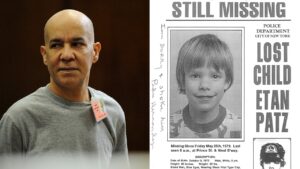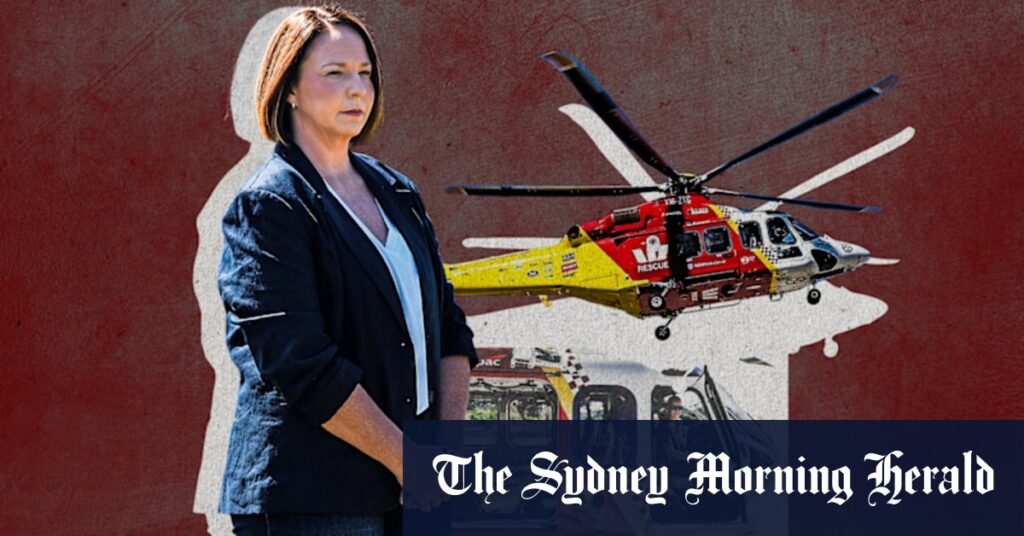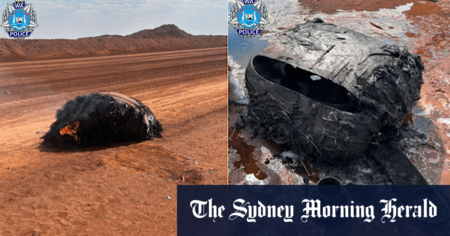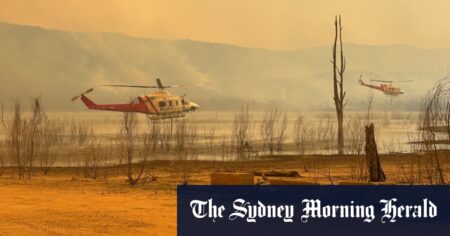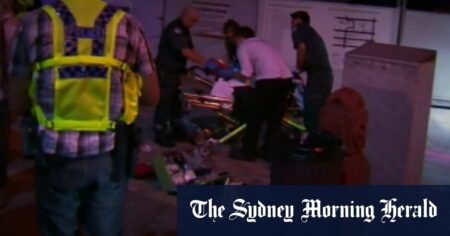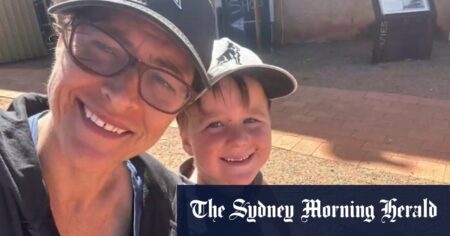The yellow and red helicopter hovers over Nine Mile Reef. Two friends have been separated from their boat as the swell rises.
From above, the spearfishers are camouflaged in the deep blue by their black wetsuits. Below, three great white sharks are circling.
The aircrew officer winches a paramedic through the gaping door dozens of metres into the ocean below. The rescuer pulls the men into a harness before their energy fades and they slip beneath the surface.
The rescue off Tweed Heads in northern NSW is one of more than 2000 missions the Westpac Rescue service performs each year, saving countless lives.
But these heroic actions mask allegations of a dark underbelly that has been festering for the past decade inside one of Australia’s most revered rescue services.
A months-long investigation by The Sydney Morning Herald and 60 Minutes can reveal allegations staff have been left broken and whistleblowers have been forced out of an organisation that celebrates its rescuers with lavish gala balls, while allegedly ignoring claims of sexual harassment, bullying and victimisation.
Ian Badham, who founded Australia’s first helicopter rescue service in Sydney in 1973, has called for an immediate government inquiry into Westpac Rescue.
“People have spent more than five decades building up the reputation of these services,” he said. “The last thing that’s needed is a breakdown in that trust that the community rightly has in aeromedical and rescue helicopter services right around this country.”
Westpac Bank, which has been a sponsor for 50 years but has no operational involvement in the service, also called for a full, independent investigation.
“We are deeply disappointed with the alleged behaviour and we are sorry that any employee has received this kind of treatment,” a Westpac Bank spokesman said.
Westpac Rescue, which declined an interview request, said in a statement that the service was committed to providing a workplace that staff were proud of and felt safe in.
“We are deeply saddened that anyone in our community feels we have fallen short of that and we apologise unreservedly,” a spokesman said.
“We reject claims that there are ongoing endemic safety or cultural issues within the organisation.”
Westpac Rescue, a distinct operation from Westpac Lifesaver, which covers Sydney, carries out operations from Newcastle to the Queensland border. It is one of eight rescue services sponsored by Westpac nationwide, each of which operates independently.
The northern service, which aims to become Australia’s leading aeromedical rescue provider, is seeking a new contract with the NSW government worth up to $500 million over 10 years.
Westpac Rescue whistleblower Stacey Price. Credit: Marija Ercecgovac / Dean Sewell
But there have been at least three whistleblower complaints to the Westpac Rescue Helicopter Service board and its executives, including one signed by 11 employees, which accused the service of endangering the health and safety of its personnel, multiple breaches of its internal code of conduct, maladministration and “creating a culture of fear”.
The allegations paint a picture of an organisation determined to protect a valuable state government contract while silencing dissent and overlooking critical safety risks.
“Westpac Rescue was built to do amazing and wonderful things, but what it’s doing for the people who work there is destroying their souls,” said one former staff member.
The former staff member is one of several employees who asked to protect their identity out of fear of retaliation in the highly specialised world of helicopter emergency rescue.
Westpac Rescue Helicopter Service’s former training coordinator Stacey Price said “enough was enough”.
“Someone has to speak up,” she said. “For me and for everyone else that is still there, and for anyone else who is watching this that’s suffering in silence wherever they are, I won’t accept this anymore.”
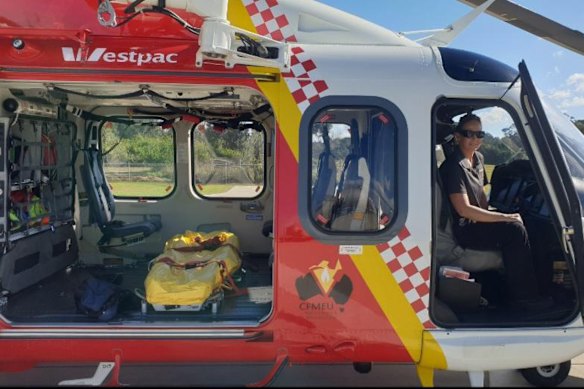
Stacey Price in a Westpac Rescue helicopter. Credit: Stacey Price
Price said she dreamed of working with the service before she started in 2018, driving each week from Sydney to Newcastle to join 120 staff across three different bases.
“If you ask a local in Newcastle, Tamworth, Lismore, some of them would say that if you work for the Westpac Rescue Helicopter Service, you are a god amongst men,” she said.
But she claims she was bullied and harassed after trying to improve training and compliance standards in an organisation that has dominated the skies above the beaches, rivers and ravines of northern NSW for five decades.
“I was asked if I was a pig on a spit. Do they take me one at a time and the others watch, or if I preferred to ‘take it rough’ by having a box ‘rammed into her c—ntainer’.”
Several staff said they were left with nowhere to turn in a workplace where it’s alleged used Borat-style mankinis were thrown on women’s desks, a senior staff member joked about having women on their knees at a golf day and complaints about one of the service’s top officers regularly sniffing women’s hair were laughed off.
“This behaviour didn’t just start. It’s ingrained,” said another former worker. “They don’t want to address the problem. They want to suppress it.”
The 11 employees who signed the whistleblower complaint in 2022 warned the board that after “putting up with this behaviour and culture for many years”, their letter was “an absolute last resort” to turn the service around.
“We request an independent and external investigation that involves confidential, on-site interviews of [Westpac] Rescue Helicopter staff and client staff members,” they said.
“This is required because the issues are too prevalent, diverse and personal to list entirely in this document, and because internal processes (formal and informal) have, to date, failed to address these long-running issues.”
Whistleblowers allege they were bullied, overlooked for promotions in favour of military friends of senior staff, or forced to sign non-disclosure agreements as a condition of receiving a payout.
“The books were cooked,” one anonymous whistleblower wrote to Westpac’s general counsel in 2023.
“They try and destroy you,” said another former staffer. “We’ll come for you. We’ll ruin you.”
Marque Lawyers managing director Michael Bradley said the crisis facing Westpac Rescue was existential. Bradley is representing Price in her compensation claim against the organisation.
“It’s toxic,” he said of the allegations. “It’s just the depth and breadth of all forms of terrible, unacceptable behaviours, sexual harassment, sexual discrimination, bullying, victimisation – all of the worst types of workplace behaviours.
“You might expect to see that in a prison yard, but not in a public service organisation.
“The management response to it has been to instinctively not just cover it up but also punish the whistleblowers. That’s the worst-case scenario for an organisation.”
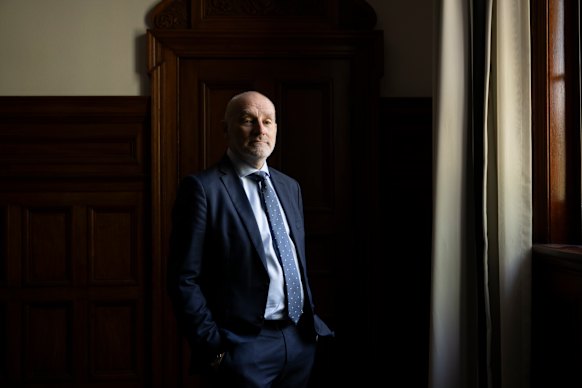
Marque Lawyers managing partner Michael Bradley. Credit: Janie Barrett
Westpac Rescue confirmed it had received three whistleblower complaints in 2022 and 2023 but said it was legally restricted from answering detailed questions about them. A spokesman said the service had appointed external investigators and acted appropriately to address their findings.
“We acknowledge those actions have not satisfied everyone but we are confident that, at all times, complaints were handled in a robust and comprehensive manner,” the spokesman said.
Several former staff said the work environment was fuelled by “old-school military-style behaviour”.
Price said she became so concerned for her safety that she considered “wearing bodycams and microphones to work to protect myself”.
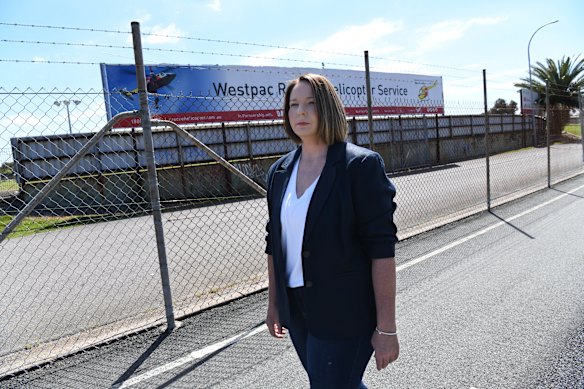
Stacey Price: “This is six years of it. It breaks you.” Credit: Dean Sewell
She alleges that when she raised her concerns with an executive, they suggested she speak to her manager.
“I’d been away training with the training operational team – all men. I was asked if I did them all together, am I a pig on a spit? Do they take me one at a time, and the others watch? How do I have it? How do I get it?” she said.
In another incident, two male Westpac Rescue Helicopter staff allegedly threatened to “ram the box into her c–tainer” as they lifted a 300-tonne cage into a dangerous goods storage container.
“They started to talk about driving the box into my c–tainer over and over and over again. Force it in, ram it in, drive it in. ‘She’s OK with it. It’s okay to be rough’.
“It was horrifying. Every time you have to speak about this sort of stuff, it is like another knife that cuts you. This is not just one bad word. This is not just one bad experience. This is six years of it. It breaks you.”
The sign at one Westpac Rescue base set the tone: “Aircraft maintenance in progress, flying tools and offensive language likely”.
Price claims she was targeted because she was a woman.
“I was a female. I was an outsider. I was not one of them,” she said.
Susana Henderson, a highly decorated former Australian Army pilot, also struggled in the organisation.
Following her first training flight, in which Henderson was asked to perform a relatively difficult manoeuvre, a senior male colleague told her he was “keeping a paper trail for her dismissal”.
The 17-year military veteran was sacked by Westpac Rescue in 2022, only six months into her role. The service has never had a female pilot pass their training period.
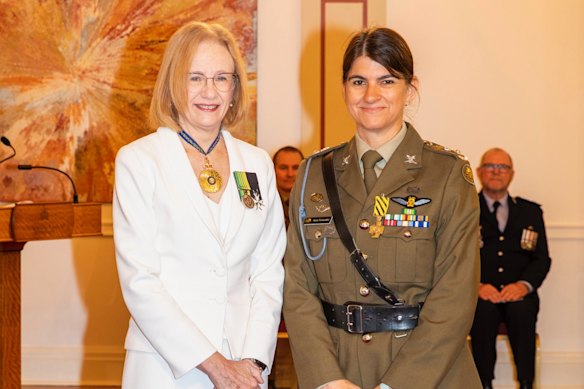
Helicopter pilot Susana Henderson with Queensland Governor Dr Jeannette Young after receiving a conspicuous service award in February for her work during the Lismore floods. Credit: Babcock Australia / Facebook
The Fair Work Commission heard Westpac Rescue’s head of flight operations, Robert Fisher, a former British Royal Navy flight commander, “repeatedly campaigned to have her employment terminated”.
The commission concluded the service had a legitimate concern about Henderson’s ability to perform a stable hover manoeuvre but that the termination was harsh and unreasonable “in all the circumstances”. It ordered her to be reinstated, but Henderson left to become a pilot for Westpac Rescue’s rival, Toll, where she passed her tests the first time.
“She was set up to fail,” claimed Price.
Westpac Rescue said its board and leadership team were committed to “legal, ethical and moral conduct” and had introduced new programs in the past two years focused on respect and leadership.
“As a mission-critical emergency service, we place immense value on professionalism and a respectful and supportive workplace culture,” a spokesman said.
“We acknowledge our organisation can always improve further and we will continue to do so.” The service said it received consistently strong employment engagement scores.
Price says threats and humiliation escalated after she allegedly discovered discrepancies in training programs, including evidence that the service had backdated certificates for doctors to treat patients by going up to 70 metres down a wire off a helicopter.
Internal documents allegedly reveal training certificates for multiple staff and medical personnel which appear to have been created in 2022 were generated in 2024 and backdated almost two years to cover gaps in the system.
“These two doctors – whilst they had the skill, the practical skill and the knowledge – they’d never actually got the piece of paper that meant contractually they were compliant,” said Price.
“What if it went wrong – critically wrong, seriously wrong? Then it becomes a coroner’s inquest. I was horrified, horrified that they took this so lightly, that my manager didn’t see this as such a critical safety risk.”
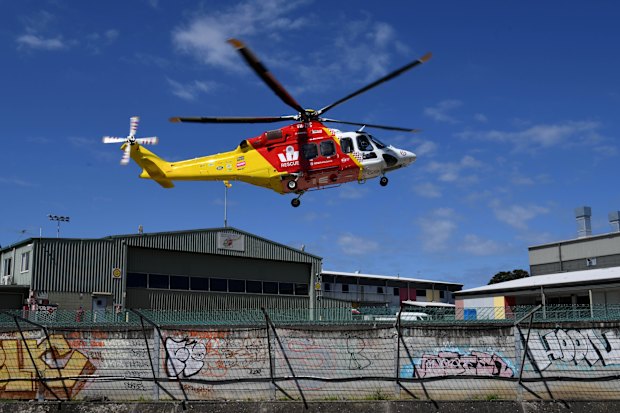
The Westpac Rescue Helicopter base in Newcastle.Credit: Dean Sewell
For decades, the service has been dependent on a taxpayer-funded contract with NSW Ambulance worth an estimated $500 million over 10 years. The contract is up for renewal in 2027 and is being renegotiated.
NSW Ambulance acting commissioner Wayne McKenna said the government was taking the allegations very seriously.
“Any mistreatment of NSW Ambulance staff or our contract providers’ staff is unacceptable,” he said.
NSW Health Minister Ryan Park said NSW Ambulance was seeking further information about the allegations from Westpac Rescue.
“I strongly encourage anyone with these complaints to refer them to SafeWork NSW, which is best placed to investigate these matters,” he said.
Westpac Bank has been a naming rights sponsor since 1973, increasing its annual funding from $25,000 to $3.8 million last year. The bank has no operational control, despite its longstanding association with the Lifesaver and Rescue services, both of which are featured prominently in Westpac’s television ads and in the bank’s annual reports.
Nine Entertainment’s regional television station, NBN, is the major media partner of the Rescue service. Nine is the owner of this masthead.
The service is also in the running to take over a larger contract after the NSW government committed an extra $158 million to funding three new bases in Port Macquarie, Wagga Wagga and Moruya.
It has even greater ambitions. In 2023, Westpac Rescue told the Supreme Court it should be allowed to expand its operations throughout Australia, arguing its survival was at risk if it was limited to northern NSW.
“In short, [Westpac Rescue] wishes to avoid the risk of extinction faced by all species who are dependent upon one source of sustenance, if that source is lost,” Justice Stephen Robb said, finding that the service’s desire to expand into new regions was reasonable.
Price said the service was already struggling to keep up with its growing remit after it took over Lismore in 2017, and the cost, scale and compliance demands of helicopter operations surged.
“They were not interested in doing the paperwork – they were not interested in filling out the online forms,” she said. “They were not overly interested in conducting all the assessments.”
Another former staff member alleges the service had a laid-back approach to submitting reports, pilot fatigue and protocol.
In 2019, an engineer allegedly breached company policy by towing a helicopter over a manhole on his own. The manhole collapsed, leaving the $20 million flying ambulance stuck in a pit. In another incident, the winch hook, used to lower aircrew and paramedics down to patients, was allegedly torn off by a ballistic cutter inside the hangar after a training exercise went wrong.
It’s alleged that the perception of pilots, aircrew and engineers as heroes led to minimal scrutiny in an environment filled with big egos and dismissive personalities.
“These are guys you go to battle with every day, and regardless of the relationship you have with them, you kind of have to put your life in their hands,” said one former staff member. “But the knives flew when you turned your back.”
Another said an “us and them” mentality developed between paramedics and parts of Westpac Rescue. “It could have threatened safety,” he said.
The relationship between different parts of the operation deteriorated to the point where paramedics were allegedly told they could not touch Westpac Rescue equipment. A former staff member overheard pilots telling air crew officers and paramedics they could not wear RM Williams boots to work because they were not pilots.
“It was a dick-measuring contest,” said the former staffer.
The power tussle between pilots and medical staff veered from the flippant to the dangerous.
In one instance, a pilot allegedly pressured a paramedic to hurry up while treating a patient going into septic shock and suffering multiple organ failure in Byron Bay so the pilot could be home in time for the end of his shift.
This intervention was defended by Westpac’s chief pilot Mike De Winton, who claimed pilots had the right to take whatever action they deemed appropriate.
But it was condemned as unacceptable by other NSW Health staff, who became concerned the pilot was exerting undue influence over paramedics and potentially putting the patient’s life at risk.
In 2023, De Winton also said he would like to kill an aircrew officer who had raised concerns about how the service was operating.
The incident was dismissed as a joke by Westpac Rescue and never reported to the Civil Aviation and Safety Authority despite growing fears about pilot mental health following several high-profile plane disasters. The authority said it was a matter for NSW Police.
De Winton, also a former officer in the British Royal Navy, remains in charge of training and checking pilots at Westpac Rescue.
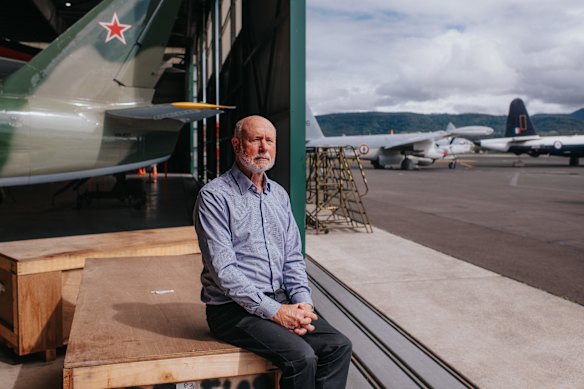
Helicopter emergency rescue pioneer Ian Badham. Credit: James Brickwood
‘Authorities must investigate’
Ian Badham, a pioneer of aeromedical rescues in Australia who founded CareFlight, said he was shocked by the allegations.
“Only the highest standards of crew effectiveness and training can deliver what the community needs when it needs. If that’s not being delivered, then the service should not operate,” he said.
“It’s putting the safety of the crew, the patient, and the community at risk.”
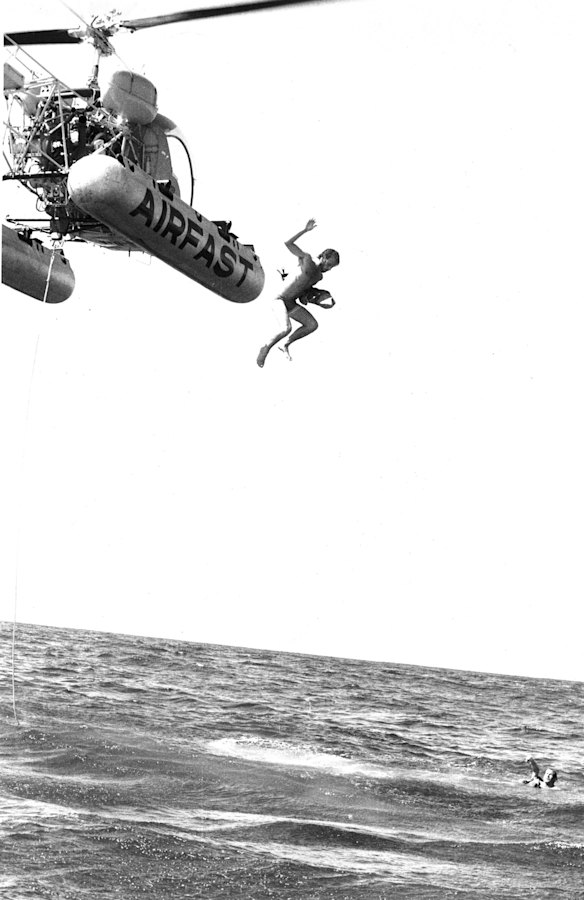
Ian Badham jumping from a rescue helicopter in 1972. Credit: Ted Golding
Rescue helicopter services have come a long way since 1972, when Badham convinced Westpac (then named the Bank of New South Wales) to pay $25,000 to help fund a skippy Bell 47 helicopter for volunteer surf lifesavers to fly in Sydney.
In the first seven months of 1973, they rescued 27 people. Last financial year, four Westpac Rescue helicopters flew 2168 missions in northern NSW alone.
Badham has called for an investigation into the service by the NSW government and federal aviation authorities.
“The regulatory authorities must investigate without delay to ensure that not just government, but the community can be assured that the very best help will be available to them when they need it,” he said.
Westpac Rescue said it had a strong safety record and that the Civil Aviation Safety Authority had verified its standards in April.
“We maintain the highest safety standards and will not compromise in any aspect of a safe work environment or flight safety,” a spokesman said.
“Every staff member is actively encouraged to identify risks and raise safety concerns.”
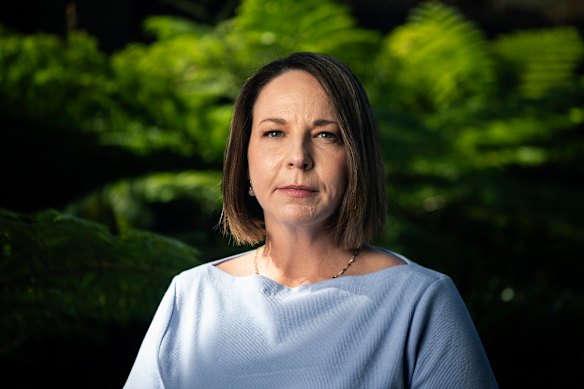
Westpac Rescue whistleblower Stacey Price. Credit: Steven Siewert
Price said she wanted to put an end to the cycle of harassment, bullying, fear and retribution she says she suffered within the organisation. Other former staff have been gagged by non-disclosure agreements.
“There used to be a sign in the window outside the office of the safety manager that said ‘The standard you walk past is the standard you accept,’ she said.
“I can’t walk past this anymore.”
Read the full article here

